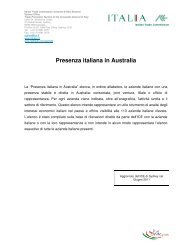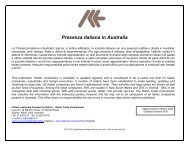Price Determination in the Australian Food Industry A Report
Price Determination in the Australian Food Industry A Report
Price Determination in the Australian Food Industry A Report
You also want an ePaper? Increase the reach of your titles
YUMPU automatically turns print PDFs into web optimized ePapers that Google loves.
Figure 40. Consumption <strong>in</strong> <strong>the</strong> domestic meat market, lamb, kg/person<br />
kg<br />
14<br />
13<br />
12<br />
11<br />
10<br />
1992 2002<br />
Source: MLA<br />
Hence <strong>the</strong> competition between meats is based on price, quality, versatility and convenience.<br />
Whilst consumers have a positive perception of lamb for quality, consistency and taste, <strong>the</strong>y still<br />
believe it to be a fatty meat (source: MLA).<br />
Seasonality is a factor that affects different cuts – summer is barbecue season and demand for<br />
lamb chops <strong>in</strong>creases at this time. W<strong>in</strong>ter is <strong>the</strong> prime sales season for roasts <strong>in</strong>clud<strong>in</strong>g legs of<br />
lamb.<br />
Drivers of producer costs<br />
Across <strong>the</strong> sheep <strong>in</strong>dustry, less than 40 per cent of producers derive more than 20 per cent of <strong>the</strong>ir<br />
<strong>in</strong>come from <strong>the</strong> production of prime lambs. So production decisions have not, <strong>in</strong> <strong>the</strong> past, been<br />
driven by returns from lamb alone for <strong>the</strong> bulk of <strong>in</strong>dustry. The specialist lamb production sector is<br />
<strong>in</strong>creas<strong>in</strong>g <strong>in</strong> size, especially <strong>in</strong> recent times with <strong>the</strong> higher returns and scope for <strong>in</strong>creased<br />
growth from export markets.<br />
A high proportion of fat lamb production <strong>in</strong> Australia is based on opportunistic behaviour, where<br />
<strong>the</strong> predom<strong>in</strong>ant activity of <strong>the</strong> producer is an alternate farm<strong>in</strong>g enterprise. The production of<br />
lambs is <strong>the</strong>refore dependent upon returns from alternate uses of land and available feed, and <strong>the</strong><br />
availability of adequate breeders. This leads to supply risk for processors and <strong>in</strong> response <strong>the</strong>y are<br />
<strong>in</strong>creas<strong>in</strong>gly buy<strong>in</strong>g stock and hav<strong>in</strong>g <strong>the</strong>m toll fed <strong>in</strong> feedlots to reduce supply and quality risk.<br />
Genetics for wool production (based on <strong>the</strong> traditional Mer<strong>in</strong>o wool sheep) are not optimum for fat<br />
lamb production which requires high growth rates <strong>in</strong> younger animals. Given that lamb prices are<br />
firm and <strong>the</strong> outlook positive, <strong>the</strong>re is an <strong>in</strong>creas<strong>in</strong>g need to dedicate production specifically to <strong>the</strong><br />
fat lamb market by chang<strong>in</strong>g genetics and production systems. These will provide greater market<br />
access, a better product and more market power.<br />
Drivers of retailer costs<br />
As with beef, <strong>the</strong> major retail buyers operate with a variety of models to ensure <strong>the</strong>y cover price,<br />
supply and quality risks. Buyers seek to achieve a target buy<strong>in</strong>g price to ma<strong>in</strong>ta<strong>in</strong> target returns for<br />
<strong>the</strong> category, based on carcass usage, process<strong>in</strong>g cost and compet<strong>in</strong>g retail prices for <strong>the</strong> category.<br />
Over time <strong>the</strong> major retail buyers vary <strong>the</strong> mix of product sourc<strong>in</strong>g between dedicated producers,<br />
paddock selection and markets (saleyard and OTH) based on market conditions. With <strong>the</strong> strong<br />
seasonal production surge that usually comes <strong>in</strong> <strong>the</strong> spr<strong>in</strong>g, <strong>the</strong> use of market sources <strong>in</strong>creases<br />
as a percentage of sourc<strong>in</strong>g <strong>in</strong>take. In 2002, 37 per cent of lambs were sold OTH, 46 per cent at<br />
auction and 15 per cent <strong>in</strong> <strong>the</strong> paddock.<br />
Dedicated supply arrangements are less common <strong>in</strong> lamb than beef and generally structured with<br />
medium-term roll<strong>in</strong>g contracts. When buy<strong>in</strong>g off-farm or <strong>in</strong> markets, OTH is <strong>the</strong> preferred method<br />
of buy<strong>in</strong>g for retailers and processors as it passes risks back to <strong>the</strong> producer – ensur<strong>in</strong>g that meat<br />
is paid on market specifications.<br />
<strong>Price</strong> <strong>Determ<strong>in</strong>ation</strong> <strong>in</strong> <strong>the</strong> <strong>Australian</strong> <strong>Food</strong> <strong>Industry</strong> A <strong>Report</strong><br />
45







